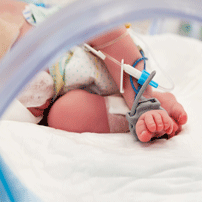Therapeutic Benefits of Induced Hypothermia in Newborns
February 16, 2018 For parents, welcoming a new baby into the world is an amazing, joyful experience. However, if something goes wrong and the baby’s health is at risk, it can quickly become one of the most terrifying experiences. When a baby does not get enough oxygen or blood flow to the brain during labor or delivery, it can cause a condition known as hypoxic-ischemic encephalopathy (HIE). This brain injury is responsible for a significant number of fetal fatalities and injuries each year. A study was recently published in the Journal of the American Medical Association, which studied the therapeutic benefits of body cooling, or hypothermia, in newborns with moderate HIE.
For parents, welcoming a new baby into the world is an amazing, joyful experience. However, if something goes wrong and the baby’s health is at risk, it can quickly become one of the most terrifying experiences. When a baby does not get enough oxygen or blood flow to the brain during labor or delivery, it can cause a condition known as hypoxic-ischemic encephalopathy (HIE). This brain injury is responsible for a significant number of fetal fatalities and injuries each year. A study was recently published in the Journal of the American Medical Association, which studied the therapeutic benefits of body cooling, or hypothermia, in newborns with moderate HIE.
A baby who is suffering from HIE often shows signs of the condition shortly after birth. Lack of crying or excessive crying, seizures, poor muscle tone, loss of reflex, difficulty breathing, low APGAR scores, vision or hearing problems, organ dysfunction, and irregular heart rate or blood pressure are all signs that the baby could be suffering from HIE. To confirm HIE, the infant will likely require an MRI or CT scan to determine the severity of the injury. If the baby demonstrated signs of seizure activity, like a fixed gaze or repetitive movement, an EEG will also be necessary. Depending on the extent of the injury, treatment options include adequate fluid intake, phototherapy, fever prevention, anti-seizure medication, and body cooling if the condition is moderate to severe.
Study Highlights
The randomized clinical trial took place between April 2008 and June 2016, which analyzed data from 21 U.S. Neonatal Research Network Centers, focusing on the therapeutic effects of hypothermia when applied between six and 24 hours after birth. The 83 infants who underwent hypothermic therapy were maintained at a temperature of 33.5 degrees Celsius for 96 hours. Eighty-five infants who did not receive hypothermic therapy were maintained at 37.0 degrees Celsius. Researchers found the following results:
- Approximately 24 percent of newborns who underwent hypothermia treatment died or suffered a disability at 18 to 22 months, which is 3.5 percent less than the group that did not undergo hypothermia to treat HIE.
- Overall, researchers found that while the evidence suggests that there may be clinical benefits to treating HIE with hypothermia when initiated at six to 24 hours post birth, additional research is necessary to prove its long-term effectiveness.
Baltimore Birth Injury Lawyers at LeViness, Tolzman & Hamilton Seek Justice for Victims of Medical Negligence
If you or someone you know had a baby who suffered from a serious medical condition like HIE and you believe the medical professional in charge of your baby’s health was negligent in the care that was provided, do not hesitate to contact the Baltimore birth injury lawyers at LeViness, Tolzman & Hamilton. Our dedicated, compassionate team will obtain the maximum financial compensation you deserve. To schedule a free consultation, call us today at800-5 47-4LAW (4529) or contact us online.
Our offices are located in Baltimore, Columbia, Glen Burnie, and Towson, allowing us to represent medical malpractice victims in Maryland, including those in Anne Arundel County, Baltimore County, Carroll County, Harford County, Howard County, Montgomery County, Maryland’s Western Counties, Prince George’s County, Queen Anne’s County, Southern Maryland, and the Eastern Shore, as well as the communities of Catonsville, Essex, Halethorpe, Middle River, Rosedale, Gwynn Oak, Brooklandville, Dundalk, Pikesville, Nottingham, Windsor Mill, Lutherville, Timonium, Sparrows Point, Ridgewood, and Elkridge.






